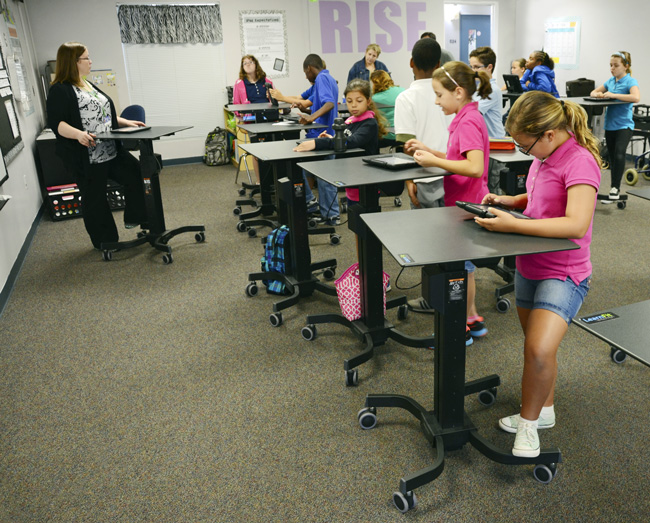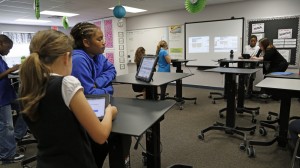
Gone are the days when it was considered a virtue to keep students disciplined, looking solemn and still when seated at their desks, hands folded neatly on top. A new trend is emerging at Flagler schools. It’s now all about “active learning,” a teaching style aimed at promoting better health and academic performance.
At Belle Terre Elementary, that means adjustable standing desks. When students returned to school this fall, they may not have had the leisure of reclining at first bell.
These LearnFits, as they’re called, are a product of a St. Paul, Minn.- based Ergotron, a company that specializes in selling mounting desks, monitors and other such supplies. They’re provided at no cost to the district. Beyond being height adjustable on the fly, they offer full mobility around the classroom.
“We’ve got a lot of research and support that shows that kids learn and retain information better, if they’re active in the learning process,” Flagler Superintendent Jacob Oliva said, “so we’ve been doing a lot of pilot classrooms where we’ve changed the traditional model of standard desks and chairs to create more learning spaces so students move around the classroom to acquire information and integrate technology.”
The district has been looking at alternative learning environments for about three years, “The entire classroom layout is something we’re exploring differently,” Oliva said.
Joseph DiPuma, a senior level IT specialist for Flagler Schools District Technology Development, says a trend the district noticed in business settings brought standing desks to the district’s attention. This was when the district was already trying to pursue their next step in innovating different learning environments.
“We really wanted to do something that focused on health and well-being, so we started kicking around the idea of standing up in the classroom,” says DiPuma.
In the initial stages, the district took a paperless, Belle Terre Elementary fourth grade classroom, since tagged with the name “Rise” (each class has its own name) and introduced what he describes as a “crappy” non-height adjustable cart. It was conspicuously alien to the room or “not what you would deploy into a classroom.”
The school then filmed two students over two days: the first day it shot the students in their normal seating environment, the second, using the cart. The following day, DiPuma and others compared the two tapes, taking notes on the students’ posture changes, body behavior, fatigue, negative impact.
The results were indicative enough that DiPuma decided a remedy was called for. So he left for two weeks to go to the Florida Educational Technology Conference in Orlando, or FETC, where he met senior Ergotron project manager Cathi Vergin. He mentioned the moves that Belle Terre Elementary had taken with the cart. A couple of days later, Ergotron sent Belle Terre Elementary a new product for testing that the company was preparing to put on the market—a strong, height-adjustable desk on wheels called the LearnFit.
It was well received enough that within a couple of weeks, Ergotron sent enough LearnFits for the rest of the class. There was no cost to the district, not even shipping, though Ergotron has learned what Apple has been teaching for years: get ’em hooked with free or discounted stuff, and they might stay with you for life.
This is where the science of ergonomics comes in, says Carrie Schmitz, an Ergotron ergonomic and wellness research manager. “Basically, an ergonomist is going to look at a specific task and decide how long can that task be engaged in before a person is risking fatigue or even muscle strain and then how long it takes to recover from that task,” she says.
Schmitz, who specializes in office and children ergonomics, had also observed the Belle Terre students utilizing DiPuma’s rudimentary cart. She noticed that as the teacher moved about the classroom, “from one wall to the next,” all the other students had to turn or crane their necks. Those using the cart simply pivoted and remained in a “completely neutral posture.”
LearnFits benefits begin with giving students more freedom than they’ve experienced in the classroom. “We know that there is a relationship between motion and cognition,” Schmitz says. “In other words, the brain benefits from physical activity. Whether it’s an adult or a child, when a person is not moving they have risks from sedentary behavior in that physical well-being suffers from putting “too much pressure on one area of your body and maybe not using other parts of your body that should be engaged.” Students’ metabolisms also benefit from standing and movement.
However, if students don’t want to stand all day, they don’t have to. There is a stool option. Some may even prefer to sit under their desks or against the wall. The teachers leave it up to them. As a further endorsement of LearnFits, the class recently chose to take their FCATs standing, so students would be more alert to the torture.
What impressed Schmitz most while observing the students at Belle Terre was how they took ownership and pride in the devices, with very little damage or loss reported. “By what we observed, students are given much less credit than they deserve in terms of making decisions for themselves in the classrooms,” schmitz said. Students took this gesture as a show of trust from the teachers, school district, and parents that they can “do the right thing.”
Additionally, students are more focused on the teacher, she says. They are less likely to look for excuses to get up and move because they’re frustrated, since they’re free to move already. One concern from parents was that the device would be a distraction for the students. “It’s been just the opposite,” says Schmitz. Comparatively, the previous desk and chair setup was like “being kept captive.”

Standing desks also add a new kind of dynamism to the classroom. “We really focus on these flexible learning environments,” says DiPuma. “The reason we really love the LearnFits, is that you can reconfigure a room on the fly,” meaning that there’s no longer a standard configuration to adhere to, whether you’re working in large or small groups.
“When you try to do active learning in a traditional workspace,” DiPuma says, students typically leave their desk and head to the center of the room, leaving all the stagnant furniture behind. “You just cut your learning per square footage by half or maybe more.”
“So the teachers love the fact that their rooms stay the same size but just have a different layout, and that the kids are able to do it on the fly and as quick as they can.”
With the widespread use of Ipads and other digital devices now utilized in the classrooms, they’re not bound by wires or static desks anymore.
With that, DiPuma says there’s a new district acronym floating around: EMMA360, which stands for Educators Must Move Around. If the teachers want students to be active, they have to follow suit. Now, each wall of the classroom is expected to be utilized during the lesson, panoramically.
While quantitative data is not yet back for review, the qualitative data has been “remarkable,” in that students are much more enthusiastic to be in school and doing their work, says Oliva.
Nevertheless, whether the district will add LearnFits in other classrooms depends, more or less, on whether the teachers want them, Oliva says. Therefore, it is too soon to make a cost projection. Whatever is needed, whether it be new furniture or the renovation of existing furniture, could be paid for with capital dollars diverted for that purpose or through grants.
“The notion that one size or one model fits all, we know is not the most effective approach to meet all the needs of the kids individually,” says Oliva. “Our job at the district level is to help provide the resource support to the teachers that they need to help ensure their student success, so we’re working with teachers and groups of people that are willing to try different things.”
(Note: The following Washington Post article, “Teacher spends two days as a student and is shocked at what she learns,” explores a related theme from a teacher’s perspective. With thanks to Andy Dance for pointing it out.)
![]()





























groot says
Excellent idea! Before I retired from the “retirement” job I had with the state here, I worked from home. They could not believe I did not want a chair. I told them, I prefer to stand for a variety of issues. They couldn’t believe it! When I started standing all day and stretching, my back issues disappeared.
Lisa says
While I think this is a step in the right direction, the photos aren’t encouraging. Many of the children have the desks set at the wrong height (too high) and I see potential for shoulder/neck injury/pain. I definitely see the benefit of a standing desk with options to sit on a stool (& lower the desks a little) but you have to have movement. Just standing all day and not moving is as bad as sitting all day without movement. Movement is key as is proper desk height, as is mentioned in the article. I just hope the kids are taught & encouraged to adjust their desks. Unfortunately, the photos above don’t reflect that.
No Apple for Teacher says
I don’t want my child standing all day. She has feet problems. What’s next, data info wired into their little heads via the New Computer Teacher who is really a robot with a female voice ? I feel sorry for children now days. Their noses are never eight inches away from their crutch, the laptop.
toni hollingsworth says
What a wonderful article about Flagler School’s computer labs. I know that Joey DiPuma works really hard to make sure all the children have everything that they need to move into the fast-paced technology world. He goes far and wide to acquire new ideas and “free” labs. I am so proud of Joey and as you may have already guessed, I am Joey’s Mom. What lucky children to have a visionary such as him. Thank you FlaglerLive !!!!!!!!
fruitcake says
How many millions is this going to cost?
KB63 says
Will wait to see what the outcome of this is. People who stand all day – Clerks, bartenders, etc. have numerous knee and foot problems. Perhaps if they alternate from class to class. It’s sad that the teachers are spending their own money for lesson plans & supplies trying to teach but the school is worried about these standing desks because that will make everything better.
Evelyn Shellenberger says
I am a former educator of 42 years to include a Flagler School Board member. I am always amazed at the critics that do not even know what they have read before they start cutting everything down. Go back and read the article again. Pick up on the words like, stools are available, one size doesn’t fit all etc. Your students are attached to that phone and computer just as much at home as they are at school. At school they are a learning tool. The one of the future. At home it is up to you, the parent to know what they are doing. I applaud the superintendent, board, and Joey for being forward thinking and trying to find ways to help students be more interested in learning. So for the critics, read first and look at what is said as if the glass was half full not empty. There is a great deal of value in this project.
gayle ford says
This is great! Now if only they would have ipad stands on them as well so the kids aren’t constantly looking down. This is an awesome step to ergonomics in education.